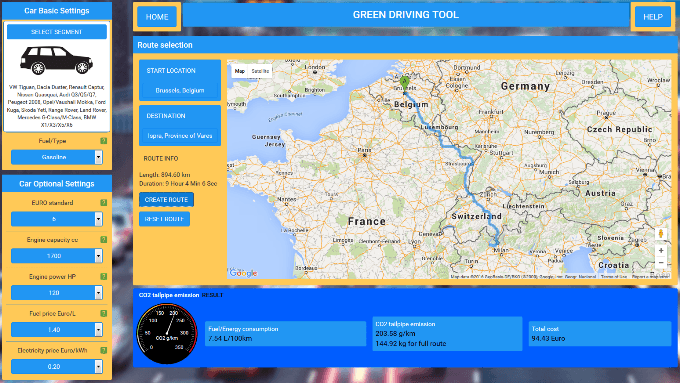Jul 26 2016
In line with the Commission's ambition to move towards low and zero-emission vehicles as outlined in the European Strategy for Low-Emission Mobility adopted on 20 July, the JRC has developed an online tool to help citizens estimate fuel costs and CO2 emissions of their daily commute or holiday trips by car, for instance.
 The Green Driving tool-measured fuel costs and CO2 emissions of a car journey from Brussels to the JRC site in Ispra, Italy (Credit: © EU, 2016)
The Green Driving tool-measured fuel costs and CO2 emissions of a car journey from Brussels to the JRC site in Ispra, Italy (Credit: © EU, 2016)
The ‘Green Driving Tool’ was launched in support of the Commission’s initiatives for the decarbonisation of transport in Europe. The interactive web-based instrument allows estimating the fuel costs and CO2 emissions of individual car journeys on the basis of variables such as car segment, engine power, fuel type and driving style. Tibor Navracsics, Commissioner for Education, Culture, Youth and Sport, responsible for the JRC, said: "The Green Driving Tool, developed by the Commission's Joint Research Centre, helps consumers make better informed choices for their car transport needs and shows them how they can lower CO2 emissions and fuel costs. It is an excellent example of how science can support policy objectives and provide practical tools to tackle societal challenges and empower citizens.”
The Green Driving Tool uses detailed map data and vehicle simulations to estimate fuel consumption, costs and CO2 emissions for any given car journey. It will therefore help raise awareness of the impact of car journeys, supporting citizens looking to make decisions on their use of cars.
Background
The detailed vehicle simulations and the estimates returned by the Green Driving tool are powered by CO2MPAS (CO2 Module for Passenger and commercial vehicles Simulation). CO2MPAS was developed by the JRC to support the introduction of the Worldwide harmonised Light vehicles Test Procedures (WLTP) in the type-approval of light-duty vehicles for what concerns the CO2targets set by regulations 443/2009 (on reduction of CO2 emissions from new passenger cars) and 510/2011 (on reduction of in CO2 emissions from light commercial vehicles).